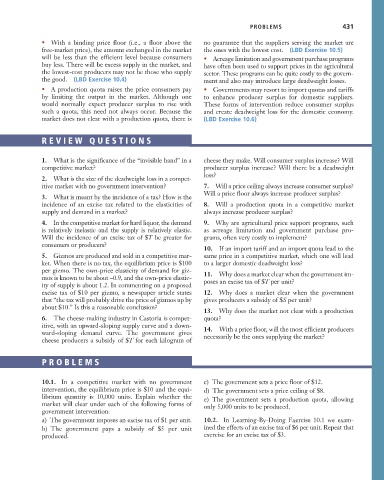Page 457 - Microeconomics, Fourth Edition
P. 457
c10competitive markets applications.qxd 7/15/10 4:58 PM Page 431
PROBLEMS 431
• With a binding price floor (i.e., a floor above the no guarantee that the suppliers serving the market are
free-market price), the amount exchanged in the market the ones with the lowest cost. (LBD Exercise 10.5)
will be less than the efficient level because consumers • Acreage limitation and government purchase programs
buy less. There will be excess supply in the market, and have often been used to support prices in the agricultural
the lowest-cost producers may not be those who supply sector. These programs can be quite costly to the govern-
the good. (LBD Exercise 10.4) ment and also may introduce large deadweight losses.
• A production quota raises the price consumers pay • Governments may resort to import quotas and tariffs
by limiting the output in the market. Although one to enhance producer surplus for domestic suppliers.
would normally expect producer surplus to rise with These forms of intervention reduce consumer surplus
such a quota, this need not always occur. Because the and create deadweight loss for the domestic economy.
market does not clear with a production quota, there is (LBD Exercise 10.6)
REVIEW QUESTIONS
1. What is the significance of the “invisible hand’’ in a cheese they make. Will consumer surplus increase? Will
competitive market? producer surplus increase? Will there be a deadweight
loss?
2. What is the size of the deadweight loss in a compet-
itive market with no government intervention? 7. Will a price ceiling always increase consumer surplus?
Will a price floor always increase producer surplus?
3. What is meant by the incidence of a tax? How is the
incidence of an excise tax related to the elasticities of 8. Will a production quota in a competitive market
supply and demand in a market? always increase producer surplus?
4. In the competitive market for hard liquor, the demand 9. Why are agricultural price support programs, such
is relatively inelastic and the supply is relatively elastic. as acreage limitation and government purchase pro-
Will the incidence of an excise tax of $T be greater for grams, often very costly to implement?
consumers or producers?
10. If an import tariff and an import quota lead to the
5. Gizmos are produced and sold in a competitive mar- same price in a competitive market, which one will lead
ket. When there is no tax, the equilibrium price is $100 to a larger domestic deadweight loss?
per gizmo. The own-price elasticity of demand for giz- 11. Why does a market clear when the government im-
mos is known to be about –0.9, and the own-price elastic- poses an excise tax of $T per unit?
ity of supply is about 1.2. In commenting on a proposed
excise tax of $10 per gizmo, a newspaper article states 12. Why does a market clear when the government
that “the tax will probably drive the price of gizmos up by gives producers a subsidy of $S per unit?
about $10.” Is this a reasonable conclusion?
13. Why does the market not clear with a production
6. The cheese-making industry in Castoria is compet- quota?
itive, with an upward-sloping supply curve and a down-
ward-sloping demand curve. The government gives 14. With a price floor, will the most efficient producers
cheese producers a subsidy of $T for each kilogram of necessarily be the ones supplying the market?
PROBLEMS
10.1. In a competitive market with no government c) The government sets a price floor of $12.
intervention, the equilibrium price is $10 and the equi- d) The government sets a price ceiling of $8.
librium quantity is 10,000 units. Explain whether the e) The government sets a production quota, allowing
market will clear under each of the following forms of only 5,000 units to be produced.
government intervention:
a) The government imposes an excise tax of $1 per unit. 10.2. In Learning-By-Doing Exercise 10.1 we exam-
b) The government pays a subsidy of $5 per unit ined the effects of an excise tax of $6 per unit. Repeat that
produced. exercise for an excise tax of $3.

